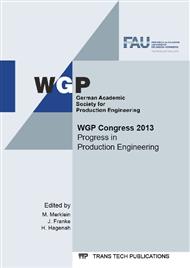[1]
M. C. Shaw, P. A. Smith, N. H. Cook, The rotary cutting tool, in: Transactions of the ASME (1952) 1065–1076
Google Scholar
[2]
P. Chen, Cutting Temperature and Forces in Machining of High-Performance Materials with Self-Propelled Rotary Tool, in: Jap. Soc. Mech. Engrs. 35 (1992) 180–185
DOI: 10.1299/jsmec1988.35.180
Google Scholar
[3]
Z. M. Wang, E. O. Ezugwu, A. Gupta, Evaluation of a Self-Propelled Rotary Tool in the Machining of Aerospace Materials, in: Tribology Transactions 41 (1998) 289–295
DOI: 10.1080/10402009808983750
Google Scholar
[4]
E. O. Ezugwu, J. Bonney, Y. Yamane, An overview of the machinability of aeroengine alloys, in: Journal of Materials Processing Technology 134 (2003) 233–253
DOI: 10.1016/s0924-0136(02)01042-7
Google Scholar
[5]
H. A. Kishawy, C. E. Becze, D. G. McIntosh, Tool performance and attainable surface quality during the machining of aerospace alloys using self-propelled rotary tools, in: Journal of Materials Processing Technology 152 (2004) 266–271
DOI: 10.1016/j.jmatprotec.2003.11.011
Google Scholar
[6]
E. Uhlmann, S. Herter, R. Zettier, Rotation macht die Schneiden leistungsfähiger, in: Werkstatt und Betrieb 140 (2007) 5 32–36
Google Scholar
[7]
E. J. A. Armarego, V. Karri, A. J. R. Smith, Fundamental studies of driven and self-propelled rotary tool cutting processes - I. Theoretical investigation, in: International Journal of Machine Tools and Manufacture 34 (1994) 6 785–801
DOI: 10.1016/0890-6955(94)90059-0
Google Scholar
[8]
E. J. A. Armarego, V. Karri, A. J. R. Smith, Fundamental studies of driven and self-propelled rotary tool cutting processes - II. Experimental investigation, in: International Journal of Machine Tools and Manufacture 34 (1994) 6 803–815
DOI: 10.1016/0890-6955(94)90060-4
Google Scholar
[9]
S. Lei, W. Liu, High-speed machining of titanium alloys using the driven rotary tool, in: International Journal of Machine Tools and Manufacture 42 (2002) 6 653–661
DOI: 10.1016/s0890-6955(02)00012-3
Google Scholar
[10]
H. Sasahara, A. Kato, H. Nakajima, H. Yamamoto, T. Muraki, M. Tsutsumi, High-speed rotary cutting of difficult-to-cut materials on multitasking lathe, in: International Journal of Machine Tools and Manufacture 48 (2008) 7 841–850
DOI: 10.1016/j.ijmachtools.2007.12.002
Google Scholar
[11]
H. Kato, T. Shikimura, Y. Morimoto, K. Shintani, T. Inoue, K. Nakagaki, A Study on Driven-Type Rotary Cutting for Finish Turning of Carburized Hardened Steel, in: Key Engineering Materials 523-524 (2012) 250–255
DOI: 10.4028/www.scientific.net/kem.523-524.250
Google Scholar
[12]
M. Roeder, E. Uhlmann, S. Richarz, F. Kaulfersch, P. Fürstmann, Smarte Werkzeuge für harte Werkstoffe, in: Futur 14 (2012) 1 10–11
Google Scholar


